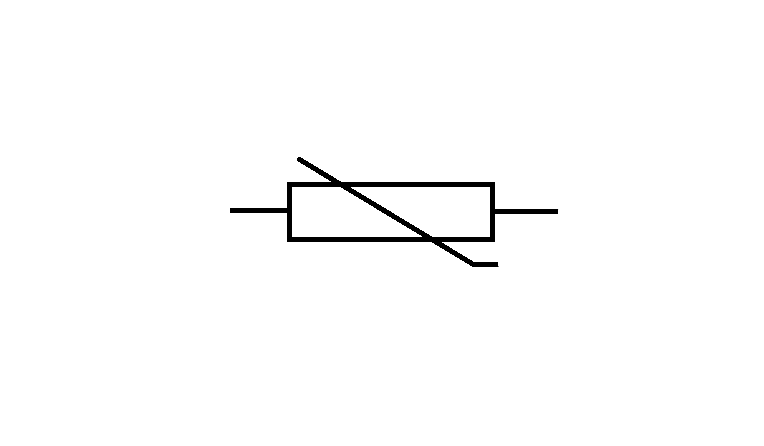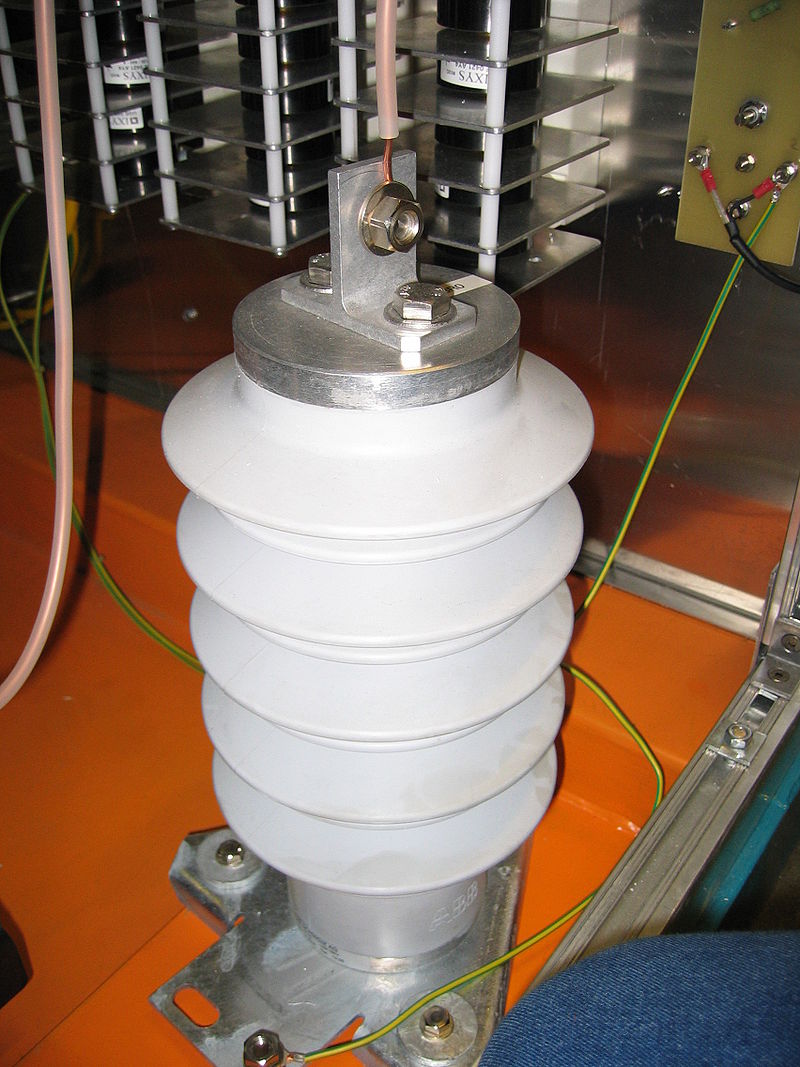
Metal-oxide varistor manufactured by Siemens & Halske AG.

Traditional varistor schematic symbol, used today for the diac. It expresses the diode-like behavior in both directions of current flow.
A varistor is an electronic component with an electrical resistance that varies with the applied voltage. Also known as a voltage-dependent resistor (VDR), it has a nonlinear, non-ohmic current–voltage characteristic that is similar to that of a diode. In contrast to a diode however, it has the same characteristic for both directions of traversing current. At low voltage it has a high electrical resistance which decreases as the voltage is raised.
Varistors are used as control or compensation elements in circuits either to provide optimal operating conditions or to protect against excessive transient voltages. When used as protection devices, they shunt the current created by the excessive voltage away from sensitive components when triggered.
The name varistor is a portmanteau of varying resistor. The term is only used for non-ohmic varying resistors. Variable resistors, such as the potentiometer and the rheostat, have ohmic characteristics.
History
The development of the varistor, in form of a new type of rectifier based on a cuprous oxide layer on copper, originated in the work by L.O. Grondahl and P.H. Geiger in 1927. Another form made from silicon carbide by R. O. Grisdale in the early 1930s was used to guard telephone lines from lightning.
Composition and operation

Modern varistor schematic symbol.
The most common type of varistor is the metal-oxide varistor (MOV). This type contains a ceramic mass of zinc oxide grains, in a matrix of other metal oxides (such as small amounts of bismuth, cobalt, manganese) sandwiched between two metal plates (the electrodes). The boundary between each grain and its neighbour forms a diode junction, which allows current to flow in only one direction. The mass of randomly oriented grains is electrically equivalent to a network of back-to-back diode pairs, each pair in parallel with many other pairs.
When a small or moderate voltage is applied across the electrodes, only a tiny current flows, caused by reverse leakage through the diode junctions. When a large voltage is applied, the diode junction breaks down due to a combination of thermionic emission and electron tunneling, and a large current flows. The result of this behaviour is a highly nonlinear current-voltage characteristic, in which the MOV has a high resistance at low voltages and a low resistance at high voltages.

Varistor current vs voltage for zinc oxide (ZnO) and silicon carbide (SiC) devices
Electrical characteristics
A varistor remains non-conductive as a shunt-mode device during normal operation when the voltage across it remains well below its "clamping voltage", thus varistors are typically used for suppressing line voltage surges. Varistors can fail for either of two reasons.
A catastrophic failure occurs from not successfully limiting a very large surge from an event like a lightning strike, where the energy involved is many orders of magnitude greater than the varistor can handle. Follow-through current resulting from a strike may melt, burn, or even vaporize the varistor. This thermal runaway is due to a lack of conformity in individual grain-boundary junctions, which leads to the failure of dominant current paths under thermal stress when the energy in a transient pulse (normally measured in joules) is too high (i.e. significantly exceeds the manufacture's "Absolute Maximum Ratings"). The probability of catastrophic failure can be reduced by increasing the rating, or using specially selected MOVs in parallel.
Cumulative degradation occurs as more surges happen. For historical reasons, many MOVs have been incorrectly specified allowing frequent swells to also degrade capacity. In this condition the varistor is not visibly damaged and outwardly appears functional (no catastrophic failure), but it no longer offers protection. Eventually, it proceeds into a shorted circuit condition as the energy discharges create a conductive channel through the oxides.
The main parameter affecting varistor life expectancy is its energy (Joule) rating. Increasing the energy rating raises the number of (defined maximum size) transient pulses that it can accommodate exponentially as well as the cumulative sum of energy from clamping lesser pulses. As these pulses occur, the "clamping voltage" it provides during each event decreases, and a varistor is typically deemed to be functionally degraded when its "clamping voltage" has changed by 10%. Manufacturer's life-expectancy charts relate current, severity and number of transients to make failure predictions based on the total energy dissipated over the life of the part.
In consumer electronics, particularly surge protectors, the MOV varistor size employed is small enough that eventually failure is expected. Other applications, such as power transmission, use VDRs of different construction in multiple configurations engineered for long life span.

High voltage varistor
Applications
To protect telecommunication lines, transient suppression devices such as 3 mil carbon blocks (IEEE C62.32), ultra-low capacitance varistors, and avalanche diodes are used. For higher frequencies, such as radio communication equipment, a gas discharge tube (GDT) may be utilized. A typical surge protector power strip is built using MOVs. Low-cost versions may use only one varistor, from the hot (live, active) to the neutral conductor. A better protector contains at least three varistors; one across each of the three pairs of conductors. In the United States, a power strip protector should have an Underwriters Laboratories (UL) 1449 3rd edition approval so that catastrophic MOV failure does not create a fire hazard.
Specifications
Voltage rating
MOVs are specified according to the voltage range that they can tolerate without damage. Other important parameters are the varistor's energy rating in joules, operating voltage, response time, maximum current, and breakdown (clamping) voltage. Energy rating is often defined using standardized transients such as 8/20 microseconds or 10/1000 microseconds, where 8 microseconds is the transient's front time and 20 microseconds is the time to half value.
Response time
The response time of the MOV is not standardized. The sub-nanosecond MOV response claim is based on the material's intrinsic response time, but will be slowed down by other factors such as the inductance of component leads and the mounting method. That response time is also qualified as insignificant when compared to a transient having an 8 µs rise-time, thereby allowing ample time for the device to slowly turn-on. When subjected to a very fast, <1 ns rise-time transient, response times for the MOV are in the 40–60 ns range.
Capacitance
Typical capacitance for consumer-sized (7–20 mm diameter) varistors are in the range of 100–2,500 pF. Smaller, lower-capacitance varistors are available with capacitance of ~1 pF for microelectronic protection, such as in cellular phones. These low-capacitance varistors are, however, unable to withstand large surge currents simply due to their compact PCB-mount size.
Hazards
While a MOV is designed to conduct significant power for very short durations (about 8 to 20 microseconds), such as caused by lightning strikes, it typically does not have the capacity to conduct sustained energy. Under normal utility voltage conditions, this is not a problem. However, certain types of faults on the utility power grid can result in sustained over-voltage conditions. Examples include a loss of a neutral conductor or shorted lines on the high voltage system. Application of sustained over-voltage to a MOV can cause high dissipation, potentially resulting in the MOV device catching fire. The National Fire Protection Association (NFPA) has documented many cases of catastrophic fires that have been caused by MOV devices in surge suppressors, and has issued bulletins on the issue.

A 130 volt, 150 J MOV that has undergone catastrophic failure, apparently as a result of a lightning strike, showing evidence of heat and smoke. The 3 amp fast-blow fuse immediately in front of the varistor blew during the same event.
A series connected thermal fuse is one solution to catastrophic MOV failure. Varistors with internal thermal protection are also available.
There are several issues to be noted regarding behavior of transient voltage surge suppressors (TVSS) incorporating MOVs under over-voltage conditions. Depending on the level of conducted current, dissipated heat may be insufficient to cause failure, but may degrade the MOV device and reduce its life expectancy. If excessive current is conducted by a MOV, it may fail catastrophically, keeping the load connected, but now without any surge protection. A user may have no indication when the surge suppressor has failed. Under the right conditions of over-voltage and line impedance, it may be possible to cause the MOV to burst into flames, the root cause of many fires and the main reason for NFPA’s concern resulting in UL1449 in 1986 and subsequent revisions in 1998 and 2009. Properly designed TVSS devices must not fail catastrophically, resulting in the opening of a thermal fuse or something equivalent that only disconnects MOV devices.
Limitations
A MOV inside a TVSS device does not provide equipment with complete power protection. In particular, a MOV device provides no protection for the connected equipment from sustained over-voltages that may result in damage to that equipment as well as to the protector device. Other sustained and harmful overvoltages may be lower and therefore ignored by a MOV device.
A varistor provides no equipment protection from inrush current surges (during equipment startup), from overcurrent (created by a short circuit), or from voltage sags (also known as a brownout); it neither senses nor affects such events. Susceptibility of electronic equipment to these other power disturbances is defined by other aspects of the system design, either inside the equipment itself or externally by means such as a UPS, a voltage regulator or a surge protector with built-in overvoltage protection (which typically consists of a voltage-sensing circuit and a relay for disconnecting the AC input when the voltage reaches a danger threshold).
Comparison to other transient suppressors
Another method for suppressing voltage spikes is the transient-voltage-suppression diode (TVS). Although diodes do not have as much capacity to conduct large surges as MOVs, diodes are not degraded by smaller surges and can be implemented with a lower "clamping voltage". MOVs degrade from repeated exposure to surges and generally have a higher "clamping voltage" so that leakage does not degrade the MOV. Both types are available over a wide range of voltages. MOVs tend to be more suitable for higher voltages, because they can conduct the higher associated energies at less cost.
Another type of transient suppressor is the gas-tube suppressor. This is a type of spark gap that may use air or an inert gas mixture and often, a small amount of radioactive material such as Ni-63, to provide a more consistent breakdown voltage and reduce response time. Unfortunately, these devices may have higher breakdown voltages and longer response times than varistors. However, they can handle significantly higher fault currents and withstand multiple high-voltage hits (for example, from lightning) without significant degradation.
Multi-layer varistor
Multi-layer varistor (MLV) devices provide electrostatic discharge protection to electronic circuits from low to medium energy transients in sensitive equipment operating at 0-120 volts dc. They have peak current ratings from about 20 to 500 amperes, and peak energy ratings from 0.05 to 2.5 joules.
Source: wikipedia.org
